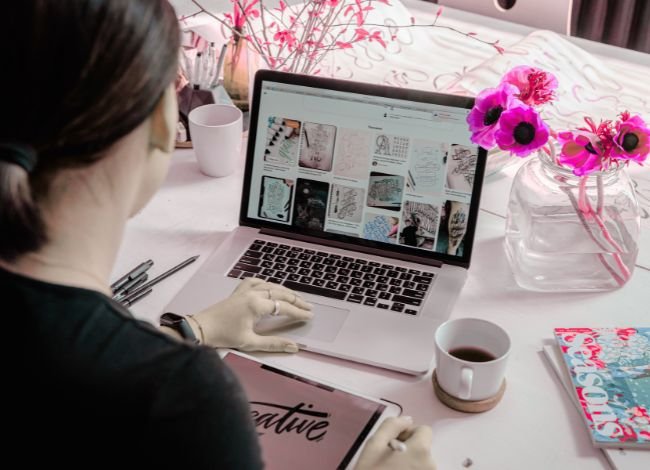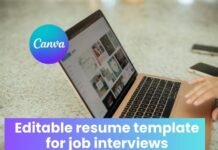When it comes to landing a design job, your resume is often the first impression you give to potential employers. A traditional black-and-white document may not be enough to showcase your creativity. This is where a creative resume template for designers becomes a powerful tool. Unlike standard resumes, a creative template combines structure with visually appealing design, enabling you to highlight your skills, experience, and personality all at once.
The design industry is highly competitive, whether you are a graphic designer, a visual designer, or even a beginner just entering the field. Employers are looking for resumes that stand out—not only in terms of content but also in presentation. The right template can help communicate your artistic sensibilities while still being professional and ATS (Applicant Tracking System) friendly.
In this article, we’ll explore different types of resumes tailored for designers. Each section will showcase examples like Graphic Designer Resume, Creative Graphic Designer Resume, Freelance Designer Resume, Visual Designer Resume, Student Resume, Beginner Resume, and Junior Designer Resume. You’ll also learn why each type of resume works, with insights into how to structure your content for maximum impact.
Graphic Designer Resume
A graphic designer resume typically strikes a balance between creativity and professionalism. It should reflect your ability to create clean layouts, choose harmonious color palettes, and use typography effectively. More importantly, it must highlight technical skills such as Adobe Photoshop, Illustrator, InDesign, Figma, or Sketch.
Your resume should also include a strong portfolio link. For graphic designers, the portfolio often carries as much weight as the resume itself. Recruiters want to see not only what you can do but how you apply your creativity in real-world projects.
Key Features of a Strong Graphic Designer Resume:
- A minimalist yet visually appealing header with your name and job title.
- Clear sections for skills, experience, and education.
- A short summary that highlights both creative and technical strengths.
- A direct link to your online portfolio or Behance/Dribbble profile.
Why This Resume Works
This resume works because it presents the designer as a professional who understands balance. It’s not overdesigned, so it remains easy to read and ATS-friendly. At the same time, the subtle use of colors, icons, and layout demonstrates your design eye. The portfolio link allows employers to dig deeper, making this resume functional as well as creative.
Creative Graphic Designer Resume
For designers who thrive on innovation, a creative graphic designer resume pushes the boundaries of traditional resume design. These resumes often feature bold typography, color gradients, or even infographic-style layouts. The idea is to demonstrate that you can break away from convention while still communicating information clearly.
This type of resume is perfect for roles in advertising agencies, creative studios, or startups where out-of-the-box thinking is highly valued.
Examples of Creative Elements to Include:
- A unique color scheme that reflects your personal brand.
- Icons or visual markers for skills such as “Adobe Illustrator,” “UX/UI,” or “Branding.”
- Infographic timelines that represent your career journey.
- Creative but readable typography that enhances the document.
Why This Resume Works
This resume works because it mirrors the designer’s professional identity. Employers looking for creative thinkers want resumes that already demonstrate innovation. By presenting your experience in a visually unique way, you give them a glimpse of your design personality. However, the key to making it work is balance—creativity should never compromise readability.
Freelance Graphic Designer Resume
Freelancers face a different challenge when it comes to resumes. Unlike traditional designers who may have worked with one or two companies, freelancers often have multiple clients across industries. A freelance graphic designer resume should showcase flexibility, adaptability, and client-oriented results.
Instead of listing just job titles, it’s more effective to emphasize projects and outcomes. For example, rather than writing “Designed logos for clients,” you might say “Created over 30 brand identities that helped small businesses increase customer engagement.”
Essential Sections for a Freelance Resume:
- Summary: Position yourself as an independent creative professional.
- Project Highlights: Short descriptions of notable freelance projects with measurable impact.
- Skills: Both technical and soft skills, including client communication and project management.
- Client Testimonials (optional): A brief quote from satisfied clients can build trust.
Why This Resume Works
This resume works because it tells a story of versatility and proven results. Companies hiring freelancers often want to see evidence that you can handle diverse projects, manage deadlines, and deliver high-quality outcomes. By structuring your resume around projects instead of roles, you demonstrate adaptability and value.
Visual Designer Resume
A visual designer resume is crafted to showcase expertise in creating digital and print visuals that enhance brand storytelling. Unlike graphic designers, visual designers often focus on the intersection of aesthetics and user experience. Employers in tech companies, design studios, and marketing agencies look for resumes that highlight a candidate’s ability to create consistent visual systems across web, mobile, and branding platforms.
A visual designer’s resume should emphasize proficiency in design systems, typography, UI patterns, and branding strategies. More importantly, it should demonstrate the ability to collaborate with UX designers, developers, and marketing teams.
Key Elements of a Visual Designer Resume:
Portfolio Links: To websites, apps, or campaigns you’ve visually designed.
Technical Skills: Tools such as Figma, Adobe XD, After Effects, and Sketch.
Design Thinking: Evidence that you can solve problems visually, not just decorate.
Branding Projects: Highlight projects where you contributed to building or refreshing brand identity.
Why This Resume Works
This resume works because it communicates the designer’s ability to combine beauty with functionality. Employers want to see not only artistic creativity but also an understanding of how design impacts user engagement and brand recognition. A well-structured creative resume template for designers in this category can make you stand out by blending clear professional details with visual storytelling.
Graphic Design Student Resume
For students or recent graduates, creating a resume can feel intimidating—especially when professional experience is limited. However, a graphic design student resume can be impactful when it emphasizes education, coursework, internships, and personal projects.
In this case, a creative resume template helps the student highlight potential rather than years of experience. The design of the resume itself can serve as proof of skill, showing that the student can apply design principles in practical ways.
What to Include in a Student Resume:
Education Section: With relevant coursework such as Typography, Motion Graphics, or UX Design.
Internship Experience: Any short-term roles in agencies, studios, or freelance projects.
Portfolio Projects: Academic or personal projects that demonstrate creativity and technical skills.
Extracurriculars: Design club memberships, workshops, or competitions.
Why This Resume Works
This resume works because it demonstrates ambition, eagerness to learn, and design potential. Recruiters understand that students won’t have long work histories, but they do want to see initiative, creativity, and a strong foundation. By using a creative resume template for designers, students can set themselves apart from peers who submit generic Word documents.
Beginner Graphic Designer Resume
When you’re just starting out, you may not have extensive experience, but that doesn’t mean your resume has to look empty. A beginner graphic designer resume should highlight transferable skills, personal projects, and any freelance or volunteer design work.
For example, if you’ve designed posters for community events, created social media graphics for a friend’s startup, or experimented with branding concepts in your free time—these can all be valuable additions to your resume.
Strategies for Beginners:
Focus on Skills Over Experience: List software and design principles you’ve mastered.
Highlight Personal Projects: Even self-initiated work shows creativity and motivation.
Use a Professional Template: This ensures your resume looks polished, even with limited content.
Add a Career Objective: Briefly explain your goals and passion for design.
Why This Resume Works
This resume works because it shows initiative and the ability to apply skills, even without years of industry experience. Recruiters value enthusiasm and a growth mindset. A creative resume template for designers ensures the layout itself looks professional, helping beginners compete with more seasoned candidates.
Junior Graphic Designer Resume
A junior graphic designer resume is ideal for those with 1–3 years of experience. At this stage, you’ve likely contributed to real-world projects, collaborated with teams, and developed stronger technical skills. The goal of your resume should be to emphasize growth, learning, and practical achievements.
Employers hiring junior designers often want individuals who can handle both creative and production tasks—things like designing layouts, assisting with branding, and preparing assets for developers or printers.
Core Features of a Junior Designer Resume:
Professional Summary: Highlight your years of experience and design strengths.
Experience Section: Focus on contributions you made to projects, even if as part of a team.
Skills: Tools, design software, and creative techniques you are confident in.
Portfolio Showcase: Demonstrate improvement and versatility in your work.
Why This Resume Works
This resume works because it demonstrates readiness for responsibility. By this point, you are no longer a beginner—you’ve proven your ability to work in professional settings. A clean, creative resume template for designers ensures your application reflects both skill and growth potential, which is exactly what hiring managers want in junior roles.
FAQs
1. Should designers always use creative resume templates?
Not always. While creative templates can make your resume stand out, some companies prefer simple, traditional formats. It’s best to adjust depending on the job role and company culture.
2. Are creative resumes ATS-friendly?
They can be, if designed correctly. Avoid overly complex graphics or text embedded in images. Use clear headings, readable fonts, and proper text formatting.
3. What’s the most important element in a designer’s resume?
Your portfolio link. No matter how creative your resume looks, employers will ultimately want to see your work samples.
4. Can students or beginners use creative templates?
Absolutely. For students and beginners, creative templates help compensate for limited experience by showing potential through design.
5. How long should a designer resume be?
Typically, one page is ideal. However, if you have extensive experience or a wide range of projects, a two-page resume may be acceptable.
Conclusion
A creative resume template for designers is more than just a document—it’s a personal branding tool. Whether you’re a student, beginner, freelancer, or junior designer, the way you present your resume can dramatically impact your chances of landing interviews.
The key is finding the right balance between creativity and professionalism. Your resume should highlight your design skills while remaining clear, concise, and easy to read. Always pair your resume with a strong portfolio, as this is where employers will evaluate your true design ability.
By tailoring your resume for the specific role—whether as a graphic designer, creative designer, freelance designer, visual designer, or student—you show not only your qualifications but also your understanding of how design communicates value.
In today’s competitive job market, the right template could make all the difference. Your resume is your first design project for an employer—so make it a creative one.

